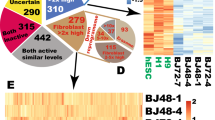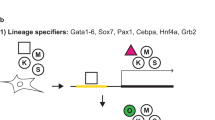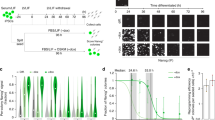Abstract
The dominant effect of transcription factors in imparting expanded potency is best exemplified by the reprogramming of fibroblasts to pluripotent cells using retrovirus-mediated transduction of defined transcription factors. In the murine system, Oct4, Sox2, c-Myc and Klf4 are sufficient to convert fibroblasts to induced pluripotent stem (iPS) cells that have many characteristics of embryonic stem (ES) cells. Here we show that the orphan nuclear receptor Esrrb functions in conjunction with Oct4 and Sox2 to mediate reprogramming of mouse embryonic fibroblasts (MEFs) to iPS cells. Esrrb-reprogrammed cells share similar expression and epigenetic signatures as ES cells. These cells are also pluripotent and can differentiate in vitro and in vivo into the three major embryonic cell lineages. Furthermore, these cells contribute to mouse chimaeras and are germline transmissible. In ES cells, Esrrb targets many genes involved in self-renewal and pluripotency. This suggests that Esrrb may mediate reprogramming through the upregulation of ES-cell-specific genes. Our findings also indicate that it is possible to reprogram MEFs without exogenous Klf transcription factors and link a nuclear receptor to somatic cell reprogramming.
This is a preview of subscription content, access via your institution
Access options
Subscribe to this journal
Receive 12 print issues and online access
$209.00 per year
only $17.42 per issue
Buy this article
- Purchase on Springer Link
- Instant access to full article PDF
Prices may be subject to local taxes which are calculated during checkout





Similar content being viewed by others
Accession codes
References
Lewitzky, M. & Yamanaka, S. Reprogramming somatic cells towards pluripotency by defined factors. Curr. Opin. Biotechnol. 18, 467–473 (2007).
Takahashi, K. & Yamanaka, S. Induction of pluripotent stem cells from mouse embryonic and adult fibroblast cultures by defined factors. Cell 126, 663–676 (2006).
Okita, K., Ichisaka, T. & Yamanaka, S. Generation of germline-competent induced pluripotent stem cells. Nature 448, 313–317 (2007).
Wernig, M. et al. In vitro reprogramming of fibroblasts into a pluripotent ES-cell-like state. Nature 448, 318–324 (2007).
Maherali, N. et al. Directly reprogrammed fibroblasts show global epigenetic remodeling and widespread tissue contribution. Cell Stem Cell 1, 55–71 (2007).
Yamanaka, S. Strategies and new developments in the generation of patient-specific pluripotent stem cells. Cell Stem Cell 1, 39–49 (2007).
Rossant, J. Stem cells: the magic brew. Nature 448, 260–262 (2007).
Park, I. H. & Daley, G. Q. Debugging cellular reprogramming. Nature Cell Biol. 9, 871–873 (2007).
Aoi, T. et al. Generation of pluripotent stem cells from adult mouse liver and stomach cells. Science 321, 699–702 (2008).
Hanna, J. et al. Direct reprogramming of terminally differentiated mature B lymphocytes to pluripotency. Cell 133, 250–264 (2008).
Hanna, J. et al. Treatment of sickle cell anemia mouse model with iPS cells generated from autologous skin. Science 318, 1920–1923 (2007).
Meissner, A., Wernig, M. & Jaenisch, R. Direct reprogramming of genetically unmodified fibroblasts into pluripotent stem cells. Nature Biotechnol. 25, 1177–1181 (2007).
Blelloch, R., Venere, M., Yen, J. & Ramalho-Santos, M. Generation of induced pluripotent stem cells in the absence of drug selection. Cell Stem Cell 1, 245–247 (2007).
Kim, J. B. et al. Pluripotent stem cells induced from adult neural stem cells by reprogramming with two factors. Nature 454, 646–650 (2008).
Szabo, P. E., Hubner, K., Scholer, H. & Mann, J. R. Allele-specific expression of imprinted genes in mouse migratory primordial germ cells. Mech. Dev. 115, 157–160 (2002).
Jiang, J. et al. A core Klf circuitry regulates self-renewal of embryonic stem cells. Nature Cell Biol. 10, 353–360 (2008).
Nakagawa, M. et al. Generation of induced pluripotent stem cells without Myc from mouse and human fibroblasts. Nature Biotechnol. 26, 101–106 (2008).
Wernig, M., Meissner, A., Cassady, J. P. & Jaenisch, R. c-Myc is dispensable for direct reprogramming of mouse fibroblasts. Cell Stem Cell 2, 10–12 (2008).
Bernstein, B. E. et al. A bivalent chromatin structure marks key developmental genes in embryonic stem cells. Cell 125, 315–326 (2006).
Ivanova, N. et al. Dissecting self-renewal in stem cells with RNA interference. Nature 442, 533–538 (2006).
Loh, Y. H. et al. The Oct4 and Nanog transcription network regulates pluripotency in mouse embryonic stem cells. Nature Genet. 38, 431–440 (2006).
Boiani, M. & Scholer, H. R. Regulatory networks in embryo-derived pluripotent stem cells. Nature Rev. Mol. Cell. Biol. 6, 872–884 (2005).
Cartwright, P. et al. LIF/STAT3 controls ES cell self-renewal and pluripotency by a Myc-dependent mechanism. Development 132, 885–896 (2005).
Matoba, R. et al. Dissecting Oct3/4-regulated gene networks in embryonic stem cells by expression profiling. PLoS ONE. 1, e26 (2006).
Masui, S. et al. Pluripotency governed by Sox2 via regulation of Oct3/4 expression in mouse embryonic stem cells. Nature Cell Biol. 9, 625–635 (2007).
Chen, X. et al. Integration of external signaling pathways with the core transcriptional network in embryonic stem cells. Cell 133, 1106–1117 (2008).
Takahashi, K., Mitsui, K. & Yamanaka, S. Role of ERas in promoting tumour-like properties in mouse embryonic stem cells. Nature 423, 541–545 (2003).
Wang, J. et al. A protein interaction network for pluripotency of embryonic stem cells. Nature 444, 364–368 (2006).
Luo, J. et al. Placental abnormalities in mouse embryos lacking the orphan nuclear receptor ERR-β. Nature 388, 778–782 (1997).
Tremblay, G. B. et al. Diethylstilbestrol regulates trophoblast stem cell differentiation as a ligand of orphan nuclear receptor ERR-β. Genes Dev. 15, 833–838 (2001).
Acknowledgements
We are grateful to the Biomedical Research Council (BMRC), Agency for Science, Technology and Research (A*STAR) and Singapore Stem Cell Consortium for funding. J.J is supported by the Singapore Millennium Foundation graduate scholarship and the NUS graduate scholarship. Y.L. and J.N. are supported by the A*STAR graduate scholarship. J.H and Y.C are supported by the NUS graduate school scholarship. We are grateful to Kuee-Theng Kuay for technical support. We thank Andrew Hutchins, Tara Huber and Edwin Cheung for critical comments on the manuscript.
Author information
Authors and Affiliations
Corresponding author
Ethics declarations
Competing interests
The authors declare no competing financial interests.
Supplementary information
Supplementary Information
Supplementary Information (PDF 3405 kb)
Rights and permissions
About this article
Cite this article
Feng, B., Jiang, J., Kraus, P. et al. Reprogramming of fibroblasts into induced pluripotent stem cells with orphan nuclear receptor Esrrb. Nat Cell Biol 11, 197–203 (2009). https://doi.org/10.1038/ncb1827
Received:
Accepted:
Published:
Issue Date:
DOI: https://doi.org/10.1038/ncb1827
This article is cited by
-
SIRT1 mediates breast cancer development and tumorigenesis controlled by estrogen-related receptor β
Breast Cancer (2024)
-
Buffy coat signatures of breast cancer risk in a prospective cohort study
Clinical Epigenetics (2023)
-
The nuclear receptor ERR cooperates with the cardiogenic factor GATA4 to orchestrate cardiomyocyte maturation
Nature Communications (2022)
-
“Cutting the Mustard” with Induced Pluripotent Stem Cells: An Overview and Applications in Healthcare Paradigm
Stem Cell Reviews and Reports (2022)
-
Molecular dynamics of estrogen-related receptors and their regulatory proteins: roles in transcriptional control for endocrine and metabolic signaling
Anatomical Science International (2022)



